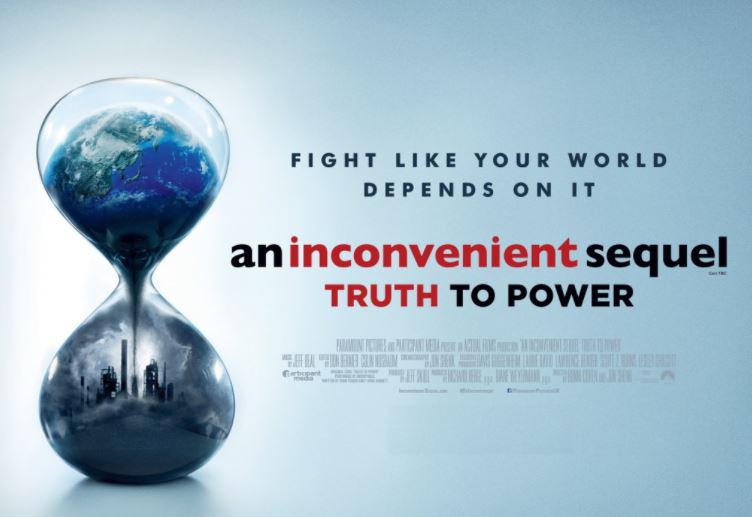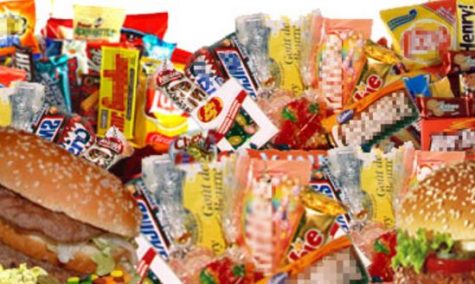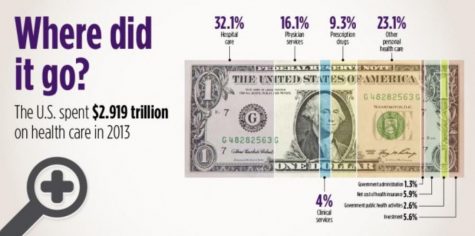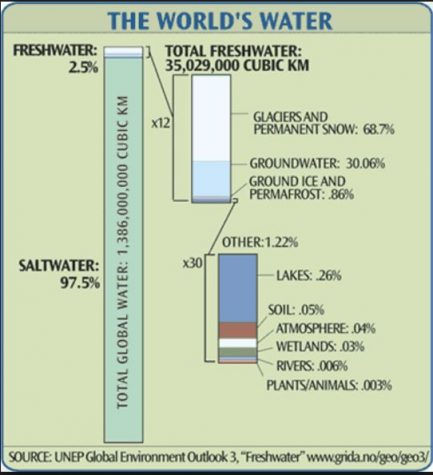Junk Food Discrepancy

June 2, 2017
“Junk food” is a universal term that reaches the ears of everyone in the entire world. Its effects are obesity, diabetes and many other health risks. Junk food kills people and puts others at serious risk. If it poses so many problems, why do we continue to make and distribute processed and health deteriorating foods? Easy answer to that — it’s cheap, profitable, and quite simple to make. Junk food contains much less nutrients than other foods, so it doesn’t require as much time to make them. For example, a freezer pizza versus homemade pizza. “Why not change the ingredients or add nutrients to them?” you might ask. Well, additional ingredients create a different taste and a longer time of processing. Junk food is a horrid and corrupt substance and should be changed or possibly even banned by law, but that’s a dramatic change that many are not willing to accept or follow through with.
Junk food can be defined as food items that contain less nutritional value than other items. Excess fat and sugar is added to make up for the lack of nutrition but it is by no means a good substitution, it’s more so for taste and material. Junk food often contains harmful processed ingredients such as high fructose corn syrup and high amounts of salt — both have lead to the increase of obesity. Between 1980 and 2014, obesity doubled in children and quadrupled in adolescents, according to the CDC (“Junk Food”). As a result of eating high sodium, high fat and high sugar products, energy gradually depletes. Between 1977 and 1996, the ratio of snack calories to total calories for children in the U.S. between the ages of 2 and 5 has increased by 30%(“Junk-Food Facts”). Junk food barely resembles foods that would support our health and sustain us for a long time(Oz, Reisman, Weil). Junk food also lacks adequate resources of nutrients such as proteins, vitamins, minerals and water, creating a decrease in overall metabolism which is directly affected by core energy levels. Depletion in energy causes one to physically and mentally lose interest in exercising (“Fast Food Nutrition”).
After consistently eating junk food, the body begins to realize the lack of complex carbohydrates and proteins that the body isn’t digesting which explains the difference in blood sugar levels. Good blood sugar levels include, 70-99 mg/dl before-meal, less than 140 mg/dl two hours after a meal and under 100 mg/dl when awakened (Spero). Soon, your body’s realization of the lack of good digestion will be registered in your brain and pancreas, diabetes will then come into effect which more often than not will possibly lead to obesity. In addition, eating junk food creates frequent mood swings and constipation. Junk food also wreaks havoc on the brain’s memory and learning process. The American Journal of Clinical Nutrition published a study that showed healthy people scoring badly on cognitive tests based on eating junk food five days. Those cognitive tests studied attention, speed and mood–all necessary skills that are needed in your everyday life. The tests also concluded that just eating junk food consistently for 5 days could deteriorate your memory as well. A toxic diet such as that would most likely result in a release of chemical reactions that then lead to inflammation in the area of the brain that specializes in memory and precise recognition(“5 Harmful Effects” ). Junk food in general is leading to a worldwide epidemic.
One of the main causes of why we continue to distribute junk food is the cost. In general, junk food costs less than healthy food. Some people may argue that, an apple or a bottle of water costs less than junk food. That is true but, it’s also one of the few rare instances. Junk food or in this case “fast food” is quick and cheap. Time and money rule today’s society. It takes time to go to a restaurant and it also takes time to prepare a healthy meal at home. Healthy food such as organic ground meat or specific vegetables can cost an arm and a leg(Oz, Reisman, Weil). The view of most Americans is “why spend so much money and time on a meal such as that when we go through the drive through and pick up a hot and ready dinner?” Supermarkets are crammed with $0.99 bags of chips but yet an apple can cost up to and sometimes more than $1.25. Respectively, health food can cost up to $1.50 more per day or about $550 depending on much junk food and healthy food you buy each day(“Eating Healthy vs. Unhealthy”). Junk food results in wasted money and improper use of time, all spent on something that was only bought because it was cheaper and required less time to prepare and eat.
In Seattle, Washington, there has been a ban on vending machines in all of the high schools in that area. From that ban comes a reduction in funding for student governments; therefore, it has cost the Seattle School Board hundreds of thousands of dollars over a course of several years. In 2001, before the ban was passed, high school associated student governments were bringing in $214,000 in profits from the vending machines, but as of this year they’ve only made $17,000 (Rosenthal). Those schools are reducing funding based on the fact that most vending machines don’t provide enough nutrition in the foods that are promoted in the machines, and almost all of the healthy foods provided don’t even taste good. According to a survey taken at Belfast Central School, 77.8 percent of students either bought food or drinks from the vending machine once a month or never at all. This suggests that the majority of BCS students are not dependent upon the vending machine.
The students were also asked about if the vending machine was taken away, would it affect them? Right about thirty percent of the students chose the option “other”. Two students had alternative ideas for the vending machine, “If there was different things in the vending machines, like say Diet Coke or something, then yeah maybe I would care, but I really don’t care to spend a whole dollar for a couple bites of something completely flavorless,” and the other student would rather eat food from the BOCES vending machine because there is a wider variety of foods and a majority of them taste good. Those foods may taste better but they’re certainly not healthy, but then again a majority of the foods found in a “healthy” vending machine aren’t necessarily healthy, the FDA sees that there is enough nutrition to label those foods as “healthy.” The highest percentage of foods that students buy include Gatorade (69.7%), chips: doritos, ruffles (60.6%), and Grandma’s Cookies (51.5%). Almost everything that is currently in our vending machine is also on the salad bar table, so in conclusion, the vending machine isn’t even necessary. The most common “healthy” foods found in a vending machine are cheese crackers, low-fat doritos and other chips, reduced-fat milk, and a rare delicacy of fruit snacks. Those select “healthy” foods don’t even taste good. If you’ve ever had the “healthy” version of cheese puffs, you’d know automatically that the orange powder coating those supposed more nutritious foods is not cheese and it certainly doesn’t taste good either. And that’s mainly because the selectiveness our taste buds is impacted by how much junk food we have previously eaten. The best way to prevent that nasty taste of junk food versus healthy food is to stop eating junk food altogether.
Did you know that almost all of the supposed “healthy” foods could be categorized as unhealthy? That is mainly based on the amount of trans fat — the bad fat — and the other bad nutrients in them. Artificial sugars and flavorings can lead to seriously bad health effects and almost all junk foods contain them(“10 Healthy”). The vending machine is basically unnecessary for Belfast not only because the food is provided elsewhere, but also because buying food on the salad bar table doesn’t require paper money, just a lunch card scan. The vending machine requires paper money at the time of buying, salad bar only requires a card. So, instead of wasting your money on the vending machine snacks, just buy the snacks at the salad bar; more of a variety and you could even be persuaded to buy healthy food.
Junk food is obviously bad for humans, so why do we continue buying and consuming them? Possibly through further research and more observations, one might be able to determine why junk food is a main pillar in our society. Hopefully, one day, we might be able to eradicate junk food completely.
Works Cited
“10 Healthy (and 10 Terrible!) Vending Machine Snacks.” Fitness Magazine. 28 Feb. 2008. Web. 26 Apr. 2017.
“Fast Food Nutrition: Junk Food’s Effect On Your Body / Nutrition / Healthy Eating.” / Nutrition / Healthy Eating. Web. 19 Apr. 2017.
Food, NDTV. “5 Harmful Effects of Junk Food.” Food.ndtv.com. 23 Aug. 2016. Web. 19 Apr. 2017.
“Junk Food.” Opposing Viewpoints Online Collection, Gale, 2017. Opposing Viewpoints in Context, Accessed 19 Apr. 2017.
Magee, Elaine. “Junk-Food Facts.” WebMD. WebMD. Web. 18 Apr. 2017.
Oz, Daphne, Rose Reisman, and Dr. Andrew Weil. “Why Does Junk Food Cost Less than Health Food? – Eating and Society.” Sharecare. Web. 18 Apr. 2017.
Polis, Carey. “Eating Healthy vs. Unhealthy Will Cost You $550 More Per Year, Study Reveals.” The Huffington Post. TheHuffingtonPost.com, 05 Dec. 2013. Web. 24 Apr. 2017.
RN, David Spero BSN. “What Is a Normal Blood Sugar Level?” Diabetes Self-Management. Web. 10 May 2017.
Rosenthal, Brian M. “A Ban on Junk Food May Harm School Funding.” Should Junk Food Be Sold in School?, edited by Roman Espejo, Greenhaven Press, 2014. At Issue. Opposing Viewpoints in Context, Accessed 19 Apr. 2017. Originally published as “School Board May Ease Ban on Junk Food,” Seattle Times, 11 Dec. 2011.





















































